1979 Japanese general election|
|
|
| Turnout | 68.01% ( 5.44pp) 5.44pp) |
|---|
|
|
First party
|
Second party
|
Third party
|
|
|

|
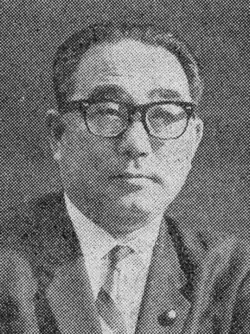
|
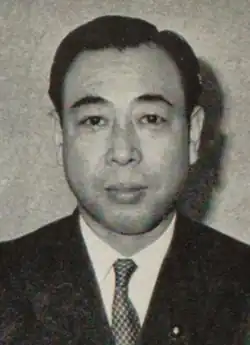
|
| Leader
|
Masayoshi Ōhira
|
Ichio Asukata
|
Yoshikatsu Takeiri
|
| Party
|
LDP
|
Socialist
|
Kōmeitō
|
| Last election
|
41.78%, 249 seats
|
20.69%, 123 seats
|
10.91%, 55 seats
|
| Seats won
|
248
|
107
|
57
|
| Seat change
|
 1 1
|
 16 16
|
 2 2
|
| Popular vote
|
24,084,131
|
10,643,450
|
5,282,683
|
| Percentage
|
44.59%
|
19.71%
|
9.78%
|
| Swing
|
 2.81pp 2.81pp
|
 0.98pp 0.98pp
|
 1.13pp 1.13pp
|
|
|
|
Fourth party
|
Fifth party
|
Sixth party
|
|
|
.jpg)
|

|
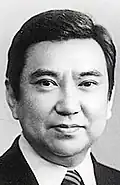
|
| Leader
|
Kenji Miyamoto
|
Sasaki Ryōsaku
|
Yōhei Kōno
|
| Party
|
JCP
|
Democratic Socialist
|
New Liberal Club
|
| Last election
|
10.38%, 17 seats
|
6.28%, 29 seats
|
4.18%, 17 seats
|
| Seats won
|
39
|
35
|
4
|
| Seat change
|
 22 22
|
 6 6
|
 13 13
|
| Popular vote
|
5,625,528
|
3,663,692
|
1,631,812
|
| Percentage
|
10.42%
|
6.78%
|
3.02%
|
| Swing
|
 0.04pp 0.04pp
|
 0.50pp 0.50pp
|
 1.16pp 1.16pp
|
|
|
|
Seventh party
|
|
|
|
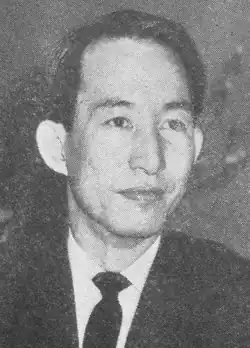
|
|
| Leader
|
Hideo Den
|
|
| Party
|
Socialist Democratic
|
|
| Last election
|
–
|
|
| Seats won
|
2
|
|
| Seat change
|
New
|
|
| Popular vote
|
368,660
|
|
| Percentage
|
0.68%
|
|
| Swing
|
New
|
| |
 Elected MPs and the leading party by vote share in each multimember district
Elected MPs and the leading party by vote share in each multimember district 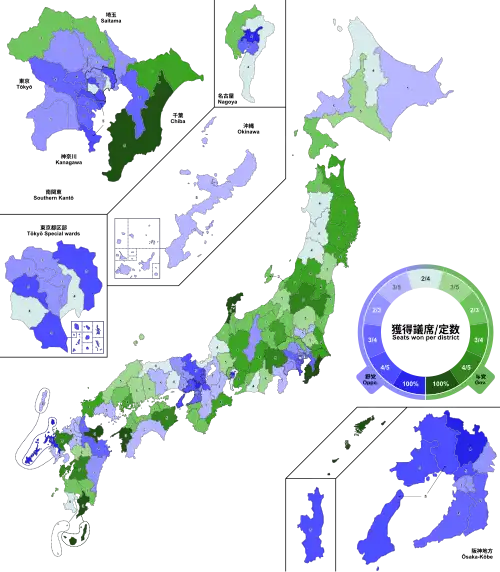 Districts where the LDP (green) or opposition (blue) won most seats; teal for ties
Districts where the LDP (green) or opposition (blue) won most seats; teal for ties |
|
General elections were held in Japan on 7 October 1979 to elect the 511 members of the House of Representatives. Prime Minister Ōhira Masayoshi's announcement that a consumption (sales) tax would be imposed was a hot-button issue in the run-up to the election. Facing widespread public disapproval, the prime minister abandoned the tax proposal.[1] The prime minister's party, the Liberal Democratic Party (LDP), ended up losing one seat, while the Japan Communist Party experienced a surge in voter support and its best ever electoral result, which mostly came at the expense of the Japan Socialist Party and the LDP-breakaway New Liberal Club.
This was the first election in the LDP's history in which the party increased its share of the popular vote compared to the previous election.
Results
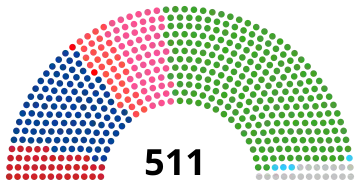 |
|---|
| Party | Votes | % | Seats | +/– |
|---|
| Liberal Democratic Party | 24,084,131 | 44.59 | 248 | −1 |
| Japan Socialist Party | 10,643,450 | 19.71 | 107 | −16 |
| Japanese Communist Party | 5,625,528 | 10.42 | 39 | +22 |
| Kōmeitō | 5,282,683 | 9.78 | 57 | +2 |
| Democratic Socialist Party | 3,663,692 | 6.78 | 35 | +6 |
| New Liberal Club | 1,631,812 | 3.02 | 4 | −13 |
| Socialist Democratic Federation | 368,660 | 0.68 | 2 | New |
| Other parties | 69,101 | 0.13 | 0 | – |
| Independents | 2,641,064 | 4.89 | 19 | −2 |
| Total | 54,010,121 | 100.00 | 511 | 0 |
|
| Valid votes | 54,010,121 | 99.06 | |
|---|
| Invalid/blank votes | 511,892 | 0.94 | |
|---|
| Total votes | 54,522,013 | 100.00 | |
|---|
| Registered voters/turnout | 80,169,924 | 68.01 | |
|---|
| Source: Statistics Bureau of Japan, National Diet |
| Seats won per district
|
 LDP
LDP  JSP
JSP  Kōmeitō
Kōmeitō  JCP
JCP  DSP (orange) & SDF (crimson)
DSP (orange) & SDF (crimson)  NLC
NLC  Independent
Independent |
By prefecture
References














.jpg)


